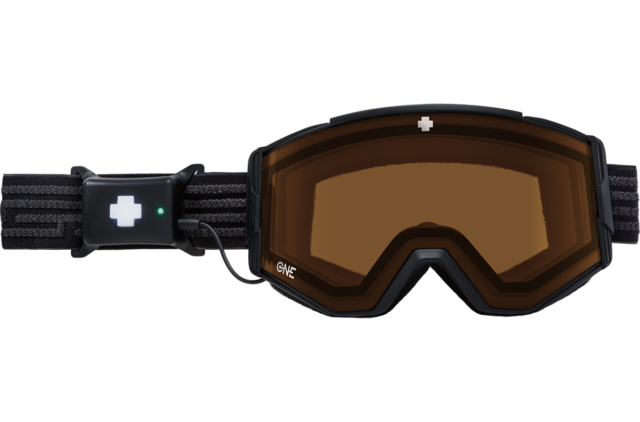Spy Ace EC Goggle
Lens Tested: Electrochromic “One Lens” (17%, 31%, & 55% VLT)
Stated Features:
- Three settings allow you to instantly adjust for any light condition – sunny (VLT: 17%), mixed (VLT: 31%) or flat (VLT: 55%)
- The lightweight (25g) control unit is powered by a lithium-ion battery pack insulated for 6 hours of cold weather performance on 2 hours of charging time
- An LED light on the control unit indicates level of charge, while vibration feedback lets you know the lens tint has changed
- Built on our Ace tooling with flexible, durable polyurethane with our scoop ventilation system
- Anti-fog injected SIC™ (Superior Injected Curve) dual-lens with anti-scratch protection
- Triple-layer Isotron™ face foam with moisture-wicking Dri-Force fleece
- Silicon-ribbed strap and universally helmet compatible
- 100% UV protection
MSRP: $275
Test Locations: Crested Butte & Telluride, CO
Days Tested: ~15

Intro
Back when people first started wearing goggles for skiing and snowboarding, you’d have to pick a goggle with a lens that you hoped would work in a wide range of light conditions. That often meant that you were left with your retinas burning on bright days, or basically blind on dark days.
Then came the introduction of goggles with swappable lenses, and you could choose whichever lens you wanted. But even with advancements in lens-swap systems, many people don’t want to carry multiple lenses with them — the lenses are often bulky, don’t fit comfortably in a pocket, and swapping lenses on many goggles is still a pain. So if the light changed in the middle of the day, you might not have the ideal lens.
This year, Spy introduced a goggle that could theoretically solve all of these issues. Their Ace EC goggle uses an electrochromic lens, which lets you change the tint of the lens with the push of a button on its built-in battery pack. Yep — one lens for all conditions.

I’ve now spent a good chunk of time using the Ace EC to find out just how useful it is in reality. Here’s what I’ve found:
Fit
The Ace EC is based on Spy’s standard Ace goggle, which fits on the slightly larger end of the spectrum. It’s not as giant as the Anon M4 or POC Orb Clarity, but it is a bit bigger than the Giro Axis and the Smith I/O7.

I have a pretty big head / face, and I’ve found the Ace EC to be pretty comfortable, and I think it should also work well for people with fairly average-sized faces. But as always, it’s best to find a shop with the Ace EC and try it on to make sure it fits your face.
Electrochromic “One Lens” Technology
We typically have a section where we detail a few of the available lenses for a particular goggle. But the Ace EC is not your typical goggle. It only has one lens, and you can’t swap it. But thanks to the electrochromic technology, the Ace EC’s single lens can switch between three different tint settings.
Changing Tint
To change the tint of the Ace EC, you simply press a big button on the goggle’s battery pack, which sits on the right side of the goggle strap. The button is easy to press with gloves or mittens, and the battery pack vibrates when you switch tints so that you know it’s changing.
Tint Settings
The Ace EC has three settings: a 17% VLT setting for bright days, a 31% VLT setting for mixed light conditions, and a 55% VLT setting for low-light days.
With those three settings, I’ve been able to happily use the Ace EC in any sort of light conditions. It gets dark enough for the brightest bluebird days, and light enough for the darkest storm days. And that’s really impressive.

I’ve found the Ace EC to be particularly useful on days when the light changes often. It’s extremely easy to just tap the button while skiing and be able to see better instantly.
In terms of covering the entire spectrum of light conditions, the Ace EC definitely works as advertised.
Contrast / Optical Quality
The Ace EC’s optics are very good, though it doesn’t create quite as much contrast as come of the high-contrast lenses that have recently hit the market (e.g., Smith’s ChromaPop, Giro’s Vivid, Anon’s Sonar, and POC’s Clarity). But in my experience, the Ace EC’s optics are just as good as any standard goggle lens, and the difference between it and the high-contrast lenses is still very subtle.
Battery Life
With a two-hour charge, Spy says the Ace EC’s battery will last for 150 tint changes or roughly six hours (i.e., a typical 9am–4pm ski day). And during my use, that stated battery life seems pretty accurate. If I charged it the night before, I’ve never had the Ace EC’s battery die during a ski day, even in temperatures down to around 10°F.
You charge the Ace EC with a cable that has a micro USB plug on one end that plugs into the goggle and a standard USB cable on the other end. I’m glad Spy went with this cable setup rather than some proprietary one since I’m prone to losing cables.

If the battery on the Ace EC dies, it reverts to the brightest 55% VLT setting. However, if you unplug the cord from the lens, the Ace EC will stay on the current tint setting. The battery has a small light that will turn yellow when its low, so if you have your friends let you know when it turns yellow, you can go to your preferred setting and unplug the cord to prevent it from reverting to the bright setting if the battery dies.
Comfort
The Ace EC’s battery pack is fairly light (stated weight of 25 g), and I honestly haven’t really noticed it while wearing it. It’s not a super streamlined design — there’s still a 2”x1”x1” box on the side of the strap. But I’ve found the Ace EC to be pretty comfortable.

One thing to note is that the Ace EC’s battery pack can get in the way if you like to wear your goggles under your helmet. It works pretty well under the Giro Combyn, but it doesn’t sit as comfortably under some other helmets (e.g., the POC Auric Cut Backcountry SPIN and the old Salomon Hacker).
Fogging
No complaints here. The Ace EC has performed as well as all the other goggles I’ve used when it comes to not fogging up. I still wouldn’t want to hike or skin with it on (I don’t do this with any goggles), but I haven’t had any major issues with fogging while skiing.
Field of View
While the Ace EC is on the larger side, its field of view is noticeably smaller than “frameless” goggles like the Anon M4, Giro Axis, and Smith I/O7. I doubt this will be an issue for most people, especially if you’re coming from a smaller goggle. But if you want a larger field of view, I’d recommend checking out the M4, Axis, or POC Orb Clarity.
Helmet Compatibility
The Ace EC has a pretty pronounced curve on its upper edge, which makes it work best with helmets that have a similarly curved brim. It aligns pretty well with the Giro Combyn and POC Auric Cut Backcountry SPIN, but if you have a helmet with a fairly flat / horizontal brim, it might not be a great fit. As always, I’d recommend bringing your helmet with you when you try on any goggle to ensure a nice fit.

Durability
No issues to report here. After around fifteen days, the Ace EC has no notable scratches, and the battery pack is still functioning perfectly. The cord connecting the battery to the lens has popped out on occasion, but only while packing or unpacking the goggle, and not while skiing.
I’ll update this review if I notice any issues down the line.
Price
The Ace EC is not a cheap goggle at $275. However, it’s not the most expensive goggle on the market, and when you consider that it’s basically like having three lenses in one, the Ace EC’s price starts to make more sense.

There are plenty of good goggles out there, and if you only need two lenses, there are a lot of cheaper goggles that come with a low-light and high-light lens. So as always, it’s all about priorities.
The Elephant in the Room
If you’ve been following the outdoor-industry news, you’ve probably heard about another electrochromic goggle — the Oakley Fall Line XL Prizm React. That goggle reportedly cycles through 9%, 15%, and 30% VLT settings, and does not have an exterior battery pack (the battery is integrated into the frame itself). The Fall Line XL Prizm React retails for $299, and we’re hoping to test it soon to compare it to the Ace EC.
Bottom Line
The Spy Ace EC is a very cool step forward in goggle technology. In my experience, its electrochromic lens truly does cover the entire range of light conditions, and its functioned flawlessly during my time with it. The Ace EC does bring a bit more complexity to the table — you have to remember to charge it, the battery pack is a bit bulky, and it’s pretty expensive. But if you want a single goggle that you can use any day on the mountain, the Ace EC is certainly worth a look.



Sounds good, but what about those of us who wear glasses? Are the goggles sized/shaped to fit over glasses?
I just asked Spy about this and they said that the Ace will work with some glasses, but it isn’t a huge frame and I couldn’t fit any of my sunglasses beneath it. So it depends on the size of your glasses. As an alternative, sportrx.com has inserts that will work inside the Ace EC.
It appears the lens has yellowish brown base color, is that accurate?
Yep — I’d call the color of the lens “amber.”
what about using the technology that has existed for years with prescription eyewear : the automatic darkening/lightening of the lens ?
The key difference between the Ace EC and “transition” lenses like those used on RX glasses is that the change in tint on the Ace EC is almost instantaneous, and you can change it whenever you want (as long as it’s charged). I haven’t used transition lens glasses, but I have seen plenty of people walking around inside for a while with their transition lenses still very dark. That said, if that technology has improved in terms of how quickly the lens changes tint, that could definitely be useful on a goggle.
It would be interesting to see a comparison with Julbo’s goggles that transition (and have been on the market for a few years now). Having used them, the transition is quick enough that I’ve never had an issue but cheaper and less bulky. Plus I don’t have to remember to manually make a change, whether hitting a button or actually changing lenses.
i knew there was something out there…
Yeah, and I’ve been using Zeal photochromics for years with zero complaints (except original price tag). I do like the 55% VLT in dull conditions that these provide as it far exceeds the max VLT of my old Zeals but I’d rather the lens do the change for me. Personally I’ll take the slower change of tint over manually pressing a button and charging a battery.
Plus I think a lot of the newer photochromic lenses boast much faster transition times and much greater variance in VLT range.
Not crapping on these. Clearly (no pun intended) it’s a sound idea and works, just not needed for me.